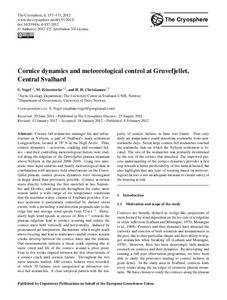| dc.contributor.author | Vogel, Stephan | |
| dc.contributor.author | Eckerstorfer, Markus | |
| dc.contributor.author | Christiansen, Hanne H. | |
| dc.date.accessioned | 2020-07-23T18:26:11Z | |
| dc.date.available | 2020-07-23T18:26:11Z | |
| dc.date.issued | 2012 | |
| dc.identifier.citation | Vogel, S.; Eckerstorfer, M. and Christiansen, H. H. (2012) Cornice dynamics and meteorological control at Gruvefjellet, Central Svalbard. The Cryosphere, 6, pp.157–171, DOI: https://doi.org/10.5194/tc-6-157-2012 | en_US |
| dc.identifier.uri | http://hdl.handle.net/11329/1385 | |
| dc.identifier.uri | http://dx.doi.org/10.25607/OBP-891 | |
| dc.description.abstract | Cornice fall avalanches endanger life and infrastructure in Nybyen, a part of Svalbard’s main settlement Longyearbyen, located at 78◦ N in the High Arctic. Thus, cornice dynamics – accretion, cracking and eventual failure – and their controlling meteorological factors were studied along the ridgeline of the Gruvefjellet plateau mountain above Nybyen in the period 2008–2010. Using two automatic time-lapse cameras and hourly meteorological data in combination with intensive field observations on the Gruvefjellet plateau, cornice process dynamics were investigated in larger detail than previously possible. Cornice accretion starts directly following the first snowfall in late September and October, and proceeds throughout the entire snow season under a wide range of air temperature conditions that the maritime winter climate of Svalbard provides. Cornice accretion is particularly controlled by distinct storm events, with a prevailing wind direction perpendicular to the ridge line and average wind speeds from 12 m s−1. Particularly high wind speeds in excess of 30 m s−1 towards the plateau ridgeline lead to cornice scouring and reduce the cornice mass both vertically and horizontally. Induced by pronounced air temperature fluctuations which might reach above freezing and lead to midwinter rainfall events, tension cracks develop between the cornice mass and the plateau. Our measurements indicate a linear crack opening due to snow creep and tilt of the cornice around a pivot point. Four to five weeks elapsed between the first observations of a cornice crack until cornice failure. Throughout the two snow seasons studied, 180 cornice failures were recorded, of which 70 failures were categorized as distinctive cornice fall avalanches. A clear temporal pattern with the majority of cornice failures in June was found. Thus only daily air temperature could determine avalanche from nonavalanche days. Seven large cornice fall avalanches reached the avalanche fans on which the Nybyen settlement is located. The size of the avalanches was primarily determined by the size of the cornice that detached. The improved process understanding of the cornice dynamics provides a first step towards a better predictability of this natural hazard, but also highlights that any type of warning based on meteorological factors is not an adequate measure to ensure safety of the housing at risk. | en_US |
| dc.language.iso | en | en_US |
| dc.rights | Attribution 3.0 | * |
| dc.rights.uri | http://creativecommons.org/licenses/by/3.0/ | * |
| dc.title | Cornice dynamics and meteorological control at Gruvefjellet, Central Svalbard. | en_US |
| dc.type | Journal Contribution | en_US |
| dc.format.pagerange | pp.157-171 | en_US |
| dc.identifier.doi | 10.5194/tc-6-157-2012 | |
| dc.subject.parameterDiscipline | Parameter Discipline::Cryosphere::Cryosphere | en_US |
| dc.bibliographicCitation.title | The Cryosphere | en_US |
| dc.bibliographicCitation.volume | 6 | en_US |
| dc.description.sdg | 11 | en_US |
| dc.description.bptype | Manual (incl. handbook, guide, cookbook etc) | en_US |
| obps.contact.contactname | S. Vogel | |
| obps.contact.contactemail | stephancvogel@googlemail.com | |
| obps.resourceurl.publisher | https://tc.copernicus.org/articles/6/157/2012/tc-6-157-2012.html | en_US |
 Repository of community practices in Ocean Research, Applications and Data/Information Management
Repository of community practices in Ocean Research, Applications and Data/Information Management

